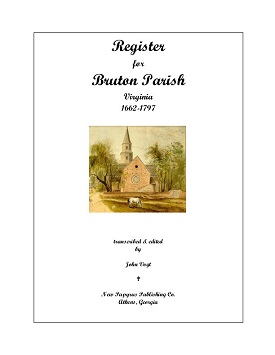






 
Home
Reference
Census Records
Military
African-American
Other States
New Titles
E-BOOKS
FREE SHIPPING IN USA
Iberian Publishing Company's On-Line Catalog:
Independent City of Williamsburg
Located in James City and York Counties. The first settlement on the site of present-day Williamsburg was known as the "Settlement between Archer's Hope and Queenes Creek" and dates from 1632/33. By the mid-seventeenth century records referred to the area as "Middle Plantation". Following the burning of the capitol building at Jamestown in 1698, the General Assembly decided to move the capital of the colony to Middle Plantation, and in the following year the community was renamed Williamsburg in honor of William III. Williamsburg was declared a "city Incorporate" in 1722, and it served as the capital of the colony until Richmond acceded to the title in 1780. In 1884 Williamsburg became one of the first towns to be elevated to the status of city. Today the city also serves as the county seat for James City County.
Most of Williamsburg's records postdate the Civil War, as the colonial and early nineteenth century books were torched by Union troops during the conflict.
For a better understanding of county boundary changes, see our new section Virginia in Maps
Iberian also has hundreds of titles in e book (PDF) format!! Click here for a complete online catalog of available titles

 BRUTON PARISH, VIRGINIA REGISTER, 1662-1797 BRUTON PARISH, VIRGINIA REGISTER, 1662-1797
transcribed & edited by John Vogt. 2004, 8x10, xiv, 119 pages, index. Paperback; printed on acid-free stock.
the parish register which survives covers the years 1662, twelve years before the formation of Bruton Parish (these records are those of the earlier Middleton Parish) up past the American Revolution to the mid 1790s. It records life events for both the great men of society as well as artisans, children, servants, slaves, bastard children, and reflects a cross-section of the Williamsburg community during its heyday when it served as the capital of the colony. More than 3,400 entries list either births, baptisms, deaths, or burials. There are no marriage records.
The editor has provided a meticulous transcription of the register, using his training in colonial paleography to correct many of the previous mis-readings. A full index is included as well as an extensive introduction. This will provide valuable information for anyone with family in the York/James City/Williamsburg area during the eighteenth century.
Dating from 1715, Bruton Parish Church in Williamsburg is the third in a series of Anglican houses of worship that began in 1658. The first, which may have been at or near the 18th-century site, was built, probably of wood, in the Old Fields at Middle Plantation, Williamsburg's name until the 66-year-old community was incorporated in 1699.
Formed from Middletown and Marston Parishes in 1674, Bruton Parish was about 10 miles square. It is named for Bruton, Somersetshire, in England, the home of then-Governor William Berkeley and Virginia secretary Thomas Ludwell. As late as 1724, the parish contained only 110 families.
The church stood near the center of Williamsburg's original survey map drawn 15 years later. Its location suggested the church's importance to the colonial community's life. Virginia governors, from the time of Alexander Spotswood, were provided with a canopied chair on a platform inside the rail opposite the raised pulpit with its overhanging sounding board. Parishioners sat in boxed pews, their walls providing privacy and protection from drafts. In the early years the sexes sat apart. A vestry book entry for January 9, 1716, says: Ordered that the Men sitt on the North side of the church, and the women on the left.
Among the Williamsburg notables buried beneath the marble flagstones inside the church was Governor Francis Fauquier, one of the best loved of the colonial governors, who died in 1768. The same year an English organ was installed. Gaolkeeper Peter Pelham was hired to play it and he brought to church with him a prisoner from the Gaol, whose job it was to pump the instrument.
Among the men of the Revolution who attended Bruton Parish Church were Thomas Jefferson, George Washington, Richard Henry Lee, George Wythe, Patrick Henry, and George Mason.
To view a digital copy of the index to this book, visit Index-Bpvr
(Close the pdf file with the left arrow to return to Iberian's catalog)
[BPVR] $27.00 (printed version)
The above title is also available as a digital e-book in PDF format:
[EBPVR] $15.00 (electronic version)
For more records pertaining to the Independent City of WILLIAMSBURG, VIRGINIA
see:
|| Virginia/W.Va. || General Reference || Military Records ||
|| Other States || Genealogy Links || New Titles || Home Page || E-Books ||
Copyright 2025 Iberian Publishing Company
|